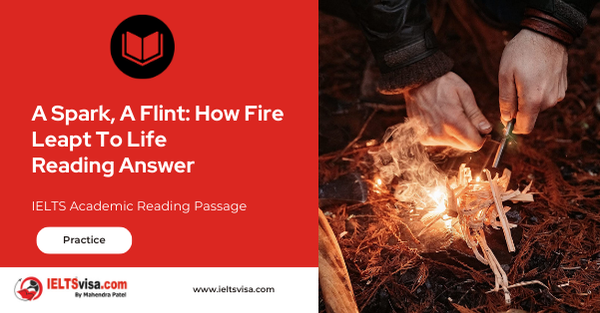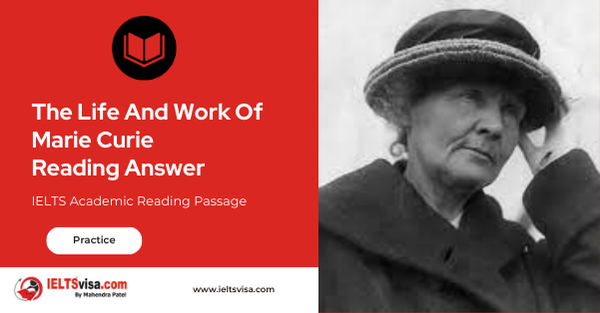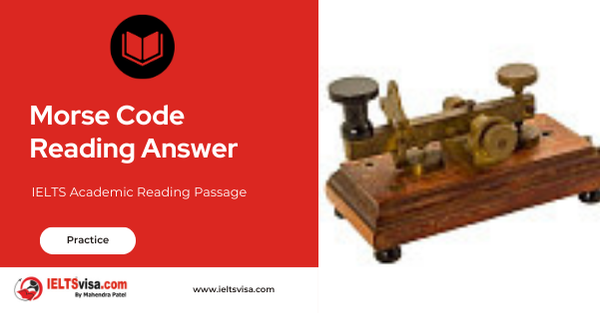A Spark, A Flint: How Fire Leapt To Life Reading Answer
IELTS Academic Reading Passage
The control of fire was the first and perhaps greatest of humanity’s steps towards a life-enhancing technology.
To early man, fire was a divine gift randomly delivered in the form of lightning, forest fire or burning lava. Unable to make flame for themselves, the earliest peoples probably stored fire by keeping slow burning logs alight or by carrying charcoal in pots.
How and where man learnt how to produce flame at will is unknown. It was probably a secondary invention, accidentally made during tool-making operations with wood or stone. Studies of primitive societies suggest that the earliest method of making fire was through friction. European peasants would insert a wooden drill in a round hole and rotate it briskly between their palms This process could be speeded up by wrapping a cord around the drill and pulling on each end.
The Ancient Greeks used lenses or concave mirrors to concentrate the sun’s rays and burning glasses were also used by Mexican Aztecs and the Chinese.
Percussion methods of fire-lighting date back to Paleolithic times, when some Stone Age tool-makers discovered that chipping flints produced sparks. The technique became more efficient after the discovery of iron, about 5000 years ago In Arctic North America, the Eskimos produced a slow-burning spark by striking quartz against iron pyrites, a compound that contains sulphur. The Chinese lit their fires by striking porcelain with bamboo. In Europe, the combination of steel, flint and tinder remained the main method of fire-lighting until the mid 19th century.
Fire-lighting was revolutionised by the discovery of phosphorus, isolated in 1669 by a German alchemist trying to transmute silver into gold. Impressed by the element’s combustibility, several 17th century chemists used it to manufacture fire-lighting devices, but the results were dangerously inflammable. With phosphorus costing the equivalent of several hundred pounds per ounce, the first matches were expensive.
The quest for a practical match really began after 1781 when a group of French chemists came up with the Phosphoric Candle or Ethereal Match, a sealed glass tube containing a twist of paper tipped with phosphorus. When the tube was broken, air rushed in, causing the phosphorus to self-combust. An even more hazardous device, popular in America, was the Instantaneous Light Box — a bottle filled with sulphuric acid into which splints treated with chemicals were dipped.
The first matches resembling those used today were made in 1827 by John Walker, an English pharmacist who borrowed the formula from a military rocket-maker called Congreve. Costing a shilling a box, Congreves were splints coated with sulphur and tipped with potassium chlorate. To light them, the user drew them quickly through folded glass paper.
Walker never patented his invention, and three years later it was copied by a Samuel Jones, who marketed his product as Lucifers. About the same time, a French chemistry student called Charles Sauria produced the first “strike-anywhere” match by substituting white phosphorus for the potassium chlorate in the Walker formula. However, since white phosphorus is a deadly poison, from 1845 match-makers exposed to its fumes succumbed to necrosis, a disease that eats away jaw-bones. It wasn’t until 1906 that the substance was eventually banned.
That was 62 years after a Swedish chemist called Pasch had discovered non-toxic red or amorphous phosphorus, a development exploited commercially by Pasch’s compatriot J E Lundstrom in 1885. Lundstrom’s safety matches were safe because the red phosphorus was non-toxic; it was painted on to the striking surface instead of the match tip, which contained potassium chlorate with a relatively high ignition temperature of 182 degrees centigrade.
America lagged behind Europe in match technology and safety standards. It wasn’t until 1900 that the Diamond Match Company bought a French patent for safety matches — but the formula did not work properly in the different climatic conditions prevailing in America and it was another 11 years before scientists finally adapted the French patent for the US.
The Americans, however, can claim several “firsts” in match technology and marketing. In 1892 the Diamond Match Company pioneered book matches. The innovation didn’t catch on until after 1896, when a brewery had the novel idea of advertising its product in match books. Today book matches are the most widely used type in the US, with 90 percent handed out free by hotels, restaurants and others.
Other American innovations include an anti-after-glow solution to prevent the match from smouldering after it has been blown out; and the waterproof match, which lights after eight hours in water.
Questions 1-8
Complete the summary below. Choose your answers from the box at the bottom of the page and write them in boxes 1 8 on your answer sheet.
NB There are more words than spaces so you will not use them all You may use any of the words more than once.
EARLY FIRE-LIGHTING METHODS
Ex. Primitive societies saw fire as a … (Example) … gift.
They tried to 1………………… burning logs or charcoal 2………………. that they could create fire themselves.
It is suspected that the first man-made flames were produced by 3…………………
The very first fire-lighting methods involved the creation of 4………………. by, for example, rapidly 5……………….. a wooden stick in a round hole.
The use of 6……………….. or persistent chipping was also widespread in Europe and among other peoples such as the Chinese and 7…………………..
European practice of this method continued until the 1850s 8………………..the discovery of phosphorus some years earlier.
List of Words
|
Mexicans |
random |
rotating |
|
despite |
preserve |
realising |
|
sunlight |
lacking |
heavenly |
|
percussion |
chance |
friction |
|
unaware |
without |
make |
|
heating |
Eskimos |
surprised |
|
until |
smoke |
|
Questions 9-15
Look at the following notes that have been made about the matches described in Reading Passage. Decide which type of match (A-H) corresponds with each description and write your answers in boxes 9-15 on your answer sheet.
NB There are more matches than descriptions so you will not use them all. You may use any match more than once.
|
Example |
Answer |
|
could be lit after soaking in water |
H |
Types of Matches
A. the Ethereal Match
B. the Instantaneous Lightbox
C. Congreves
D. Lucifers
E. the first strike-anywhere match
F. Lundstrom’s safety match
G. book matches
H. waterproof matches
9. made using a less poisonous type of phosphorus
10. identical to a previous type of match
11. caused a deadly illness
12. first to look like modern matches
13. first matches used for advertising
14. relied on an airtight glass container
15. made with the help of an army design

Solution:A Spark, A Flint: How Fire Leapt To Life Reading Answer
| 1. preserve | 9. F |
| 2. unaware | 10. D |
| 3. chance | 11. E |
| 4. friction | 12. C |
| 5. rotating | 13. G |
| 6. percussion | 14. A |
| 7. Eskimos | 15. C |
| 8. despite |
Review and Practice
- Regularly practice with IELTS reading samples and time yourself to get used to the pressure of the exam.
- Review your mistakes to understand where you went wrong and how to avoid similar errors in the future.
Our Books
Master IELTS Speaking Part 1
IELTS Writing Task 1 Book
IELTS Writing Task 2 Book
A spark, a flint: How fire leapt to life Reading Answer Explanation
| Question NO | Question Types | Answer | Keywords | Supporting Sentence | Location of Keywords | Explanations |
|---|---|---|---|---|---|---|
| 1 | Solution and Explanation | Preserve | burning, tried, logs, charcoal | Unable to make flame for themselves, the earliest peoples probably stored fire by keeping slow-burning logs alight or by carrying charcoal in pots. | First Paragraph, second line | Since ancient times, people have revered fire as a divine gift. But because they didn’t know how to manufacture it, early people simply stored or conserved it. |
| 2 | Solution and Explanation | Unaware | create, fire, themselves | Unable to make flame for themselves, the earliest peoples probably stored fire by keeping slow-burning logs alight or by carrying charcoal in pots. | First paragraph, second line | The text claims that younger generations tried to preserve fire since they couldn’t or didn’t know how to make it. |
| 3 | Solution and Explanation | Chance | fire-lightning, methods, creation | It was probably a secondary invention, accidentally made during tool-making operations with wood or stone. | Paragraph 2, second line | The creation of flames can be regarded as such, per the paragraph, because it happened accidentally or by chance. |
| 4 | Solution and Explanation | Friction | fire-lightning, methods, creation | Studies of primitive societies suggest that the earliest method of making fire was through friction. | Paragraph 2, line 3 | The passage makes it obvious that the fire lighting method was the oldest known method of manufacturing. As a result, friction was used as a technique of lighting fire. |
| 5 | Solution and Explanation | Rotating | wooden stick, round hole | European peasants would insert a wooden drill in a round hole and rotate it briskly between their palms. | Paragraph 2, last line | This operation could be sped up by pulling on each end of a cable that has been wrapped around the drill, as was mentioned in the paragraph. |
| 6 | Solution and Explanation | Percussion | chipping, widespread, Europe, Chinese | Percussion methods of fire-lighting date back to Paleolithic times, when some Stone Age tool-makers discovered that chipping flints produced sparks. | Paragraph 4, line 1 | In order to create a spark, the percussion technique, which is popular in Europe and other nations, entails constant chipping. |
| 7 | Solution and Explanation | Eskimos | European, practice, method | Eskimos produced a slow-burning spark by striking quartz against iron pyrites, a compound that contains sulfur. | Paragraph 4, fourth line | A collection of closely related indigenous peoples is referred to as the “Eskimos.” They used percussion methods too. |
| 8 | Solution and Explanation | Despite | discovery, phosphorus, years | Fire-lighting was revolutionized by the discovery of phosphorus, isolated in 1669 by a German alchemist trying to transmute silver into gold. | Paragraph 5, First line | The traditional form of lighting was still used by Europeans up until the 1850s despite the arrival of phosphorus in 1669. |
| 9 | Types of Matches | F | less, poisonous, phosphorus | Lundstrom’s safety matches were safe because the red phosphorus was non-toxic. | Ninth Paragraph, Last-line | Lundstrom developed less poisonous or non-toxic phosphorus to make safety matches. |
| 10 | Types of Matches | D | identical, previous, type | Walker never patented his invention, and three years later it was copied by Samuel Jones, who marketed his product as lucifers. | Eighth Paragraph, First line | Samuel Jones produced a product under the name Lucifers that was similar to Walker’s invention. |
| 11 | Types of Matches | E | deadly, illness | White phosphorus is a deadly poison; from 1845 match-makers exposed to its fumes succumbed to necrosis. | Eighth Paragraph, third line | The strike-anywhere match by Charles Sauria caused necrosis, a fatal illness that eats jawbones. |
| 12 | Types of Matches | C | modern, matches | The first matches resembling those used today were made in 1827 by John Walker, who borrowed the formula from Congreve. | Seventh Paragraph, first line | Congreve matches were the first to resemble modern matches. |
| 13 | Types of Matches | G | modern, matches, advertising | The innovation didn’t catch on until after 1896 when a brewery had the novel idea of advertising in matchbooks. | Eleventh paragraph, third line | Marketing matches in matchbooks began in 1896, sparking popularity. |
| 14 | Types of Matches | A | airtight, glass, container | Ethereal Match, a sealed glass tube containing a twist of paper tipped with phosphorus. | Sixth Paragraph, first line | The Ethereal match was a sealed glass tube with phosphorus-tipped paper. |
| 15 | Types of Matches | C | help, army, design | Matches resembling those used today were made in 1827 by John Walker, who borrowed from a military rocket-maker called Congreve. | Seventh paragraph, first line | John Walker designed matches in 1827 based on a military rocket-maker’s concept. |
Practice IELTS Other Modules
IELTS Listening
The IELTS Listening test assesses how well you can understand spoken English in various contexts. It lasts about 30 minutes and is divided into four sections with a total of 40 questions. The listening tasks become increasingly difficult as the test progresses.
IELTS Academic Reading
The IELTS Academic Reading section assesses your ability to understand and interpret a variety of texts in academic settings. It is designed to evaluate a range of reading skills, including skimming for gist, reading for main ideas, reading for detail, understanding inferences, and recognizing a writer's opinions and arguments.
IELTS Speaking
The IELTS Speaking test assesses your ability to communicate in English on everyday topics. It lasts 11-14 minutes and consists of three parts: introduction, cue card, and a discussion based on the cue card topic.
IELTS General Reading
IELTS General Reading tests your ability to understand and interpret various types of texts. Here are some key areas and types of content you can expect to encounter in the reading section, along with tips for effective preparation.
IELTS Academic Writing Task 1
In IELTS Academic Writing Task 1, you are presented with a visual representation of information, such as graphs, charts, tables, or diagrams, and you are required to summarize, compare, or explain the data in your own words.
IELTS General Writing Task 1
In IELTS General Writing Task 1, you are required to write a letter based on a given situation. The letter can be formal, semi-formal, or informal, depending on the prompt. Here’s a breakdown of the key components to include in your letter
IELTS Academic Writing Task 2
In IELTS Academic Writing Task 2, you are required to write an essay in response to a question or topic. Here’s a guide to help you understand the essential elements of this task
IELTS Exam Tips
To succeed in the IELTS exam, practice regularly, familiarize yourself with the test format, improve your vocabulary, develop time management skills, and take mock tests to build confidence.
Grammer for IELTS
Grammar is the foundation of effective communication in English. Understanding tense usage, subject-verb agreement, and sentence structure enhances clarity and coherence in writing and speaking.
Vocabulary for IELTS
Vocabulary plays a crucial role in the IELTS (International English Language Testing System) exam, especially in the Speaking and Writing sections. Here’s an overview of why vocabulary is important and how it impacts your performance
RECENT IELTS SAMPLES QUESTIONS AND ANSWERS
The Life And work Of Marie Curie Reading Answer
Marie Curie is probably the most famous woman scientist who has ever lived. Born Maria...
Becoming An Expert Reading Answer
A Expertise is commitment coupled with creativity. Specifically, it is the commitment of...
STUDY CENTRE COURSES Reading Answer
SELF-STUDY TIPS AHowever difficult you find it to arrange your time, it will pay off in the...
The Extrinct Grass In Britain Reading Answer
A The British grass interrupted brome was said to be extinct, just like the Dodo. Called...
Morse Code Reading Answer
A. A new satellite-based system is being implemented to replace Morse code for sending...
Magnetic Therapy Reading Answer
AMagnetic therapy, which is a $5-billion market worldwide, is a form of alternative medicine...













